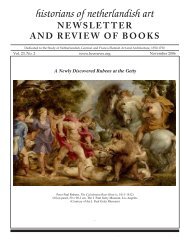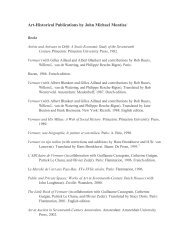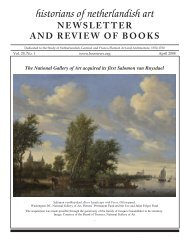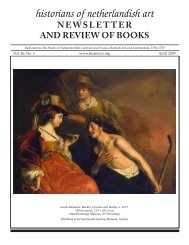newsletter - Historians of Netherlandish Art
newsletter - Historians of Netherlandish Art
newsletter - Historians of Netherlandish Art
Create successful ePaper yourself
Turn your PDF publications into a flip-book with our unique Google optimized e-Paper software.
135 authentic works; a separate DVD lists a great many others<br />
known from prints and archives.<br />
Jaap van der Veen’s biographical essay makes the most<br />
<strong>of</strong> the meager documents on a painter who never married or<br />
encountered legal quandaries. It speculates that Backer’s fi rst<br />
Amsterdam teacher was Jacob Pynas, who may have shared<br />
his Mennonite beliefs. The artist then approached Lambert<br />
Jacobsz. in Leeuwarden to acquire the principles <strong>of</strong> Rubensian<br />
history painting. Upon returning to Amsterdam, various <strong>of</strong><br />
his innovations were successful, including portraits all’antica,<br />
arcadian scenes inspired by Guarini’s drama, and uncustomary<br />
Biblical scenes. Scaling the social ladder, Backer’s fi nest hour<br />
was a commission for the Stadtholder’s palace: a maidenly personifi<br />
cation <strong>of</strong> the Dutch Republic, Italianate in symbolism but<br />
clad in red, white, and blue. We glimpse some <strong>of</strong> the master’s<br />
self-esteem when another princely patron demanded a price estimate<br />
in advance. Backer, alluding to his hurt pride as budding<br />
courtier, answered that “he could not do this and was not wont<br />
to do so, but he would demonstrate to be acting honestly.”<br />
Despite such pretensions he ultimately failed to reach the top<br />
end <strong>of</strong> the market.<br />
Peter van den Brink’s essay, exploring all aspects <strong>of</strong><br />
Backer’s art, identifi es many hitherto unknown works and<br />
brings the master’s qualities as a portraitist to the fore. In history<br />
painting, it recognizes Rubens rather than Rembrandt as<br />
his example. Prints in particular provided models for dialogue<br />
scenes involving half fi gures. Backer reused the same hands,<br />
faces, and poses in different settings; this observation provides<br />
a raison d’être for works that have usually been interpreted as<br />
character heads.<br />
A series <strong>of</strong> drawings reveals how Backer sat next to<br />
Govaert Flinck and Jacob van Loo making “academy fi gures”,<br />
studies from the nude. He probably thought out historical narratives<br />
in advance and drew his models in appropriate poses.<br />
This method seems to underlie the painting Venus, Adonis, and<br />
Amor (Fulda) and the monumental Diana and her Nymphs (St.<br />
Petersburg). The latter work, now recognized as a Backer, is the<br />
master’s tribute to no one less than Titian, improving wittily<br />
on the image tradition. The painting shows Diana’s naked back<br />
close at hand. We, the viewers, are put in Actaeon’s position:<br />
the goddess is about to turn her head. In a second, she will<br />
discover our presence and set her dogs on us.<br />
Backer, a “good colorist”, “understood well how to make<br />
a good nude”, to quote his Antwerp colleague Jean Meyssens.<br />
Lively brushwork, especially in representing fl esh, was probably<br />
his main asset. Van den Brink’s detailed analysis relishes<br />
the artist’s joie de peindre. It is unlikely that Backer used assistants<br />
since he had such a swift brush. (Yet, one is sometimes<br />
reminded <strong>of</strong> Michelangelo’s retort, when Vasari boasted about<br />
fi nishing his work so quickly: “So it appears!”) A contemporary<br />
reported that one could arrive in Backer’s studio and have<br />
one’s portrait done, including the hands, collar, and fur, on the<br />
same day. A catalogue entry by Michiel Franken suggests that<br />
this report was more than an anecdote, analyzing how precise<br />
wet-in-wet brushstrokes exploit the ochre ground for the<br />
middle tones. One <strong>of</strong> Backer’s fi nest works, however, does not<br />
display such bravura but depicts a woman in elaborate dress as<br />
a pensive Muse Euterpe. Due to its “unparalleled evocation <strong>of</strong><br />
swishing satin,” the portrait is among the most beautiful <strong>of</strong> the<br />
Dutch Golden Age, as Bob van den Boogert concludes.<br />
The book adequately reconstructs why Backer’s contempo-<br />
raries held him in such esteem. It is therefore an important contribution<br />
to our knowledge <strong>of</strong> one <strong>of</strong> the most exciting decades<br />
for history painting in Amsterdam, the 1640s.<br />
Backer’s works must have made an impact on his pupils<br />
in particular, including Jan van Noordt, and colleagues such as<br />
Flinck and Ferdinand Bol. This realization opens up avenues<br />
for further research, which is highly desireable if only for further<br />
nuancing such a contested notion as ‘Dutch classicism.’<br />
Thijs Weststeijn<br />
University <strong>of</strong> Amsterdam<br />
Friedrich Scheele and Annette Kanzenbach (eds.),<br />
Ludolf Backhuysen. Emden 1630 – Amsterdam<br />
1708. [Cat. exh. Ostfriesisches Landesmuseum Emden,<br />
Emden, November 30, 2008 – March 1, 2009.]<br />
(Veröffentlichungen des Ostfriesischen Landesmuseum<br />
Emden 27). Munich/ Berlin: Deutscher Kunstverlag,<br />
2008. 180 pp, 83 colour illus., 5 b&w illus. ISBN<br />
978-3-422-06875-9.<br />
The singular achievement <strong>of</strong> Ludolf Backhuysen as the<br />
Dutch Golden Age’s master <strong>of</strong> the monumental tempest fi rst<br />
received its full due with a monographic exhibition in Emden<br />
and Amsterdam, his native and adoptive cities, in 1985.<br />
Backhuysen’s scholarly recognition was subsequently crowned<br />
with the publication <strong>of</strong> a handsome monograph by Gerlinde de<br />
Beer in 2002, based on the author’s dissertation at the Christian-<br />
Albrechts-Universität in Kiel in 1993. The Ostfriesisches<br />
Landesmuseum recently marked the 300th anniversary <strong>of</strong> the<br />
artist’s death with another monographic exhibition. Although<br />
separated by 25 years, this project explicitly seeks to avoid duplicating<br />
that effort. Instead it takes a strikingly specifi c tack, in<br />
addressing the social and pr<strong>of</strong>essional context <strong>of</strong> Backhuysen’s<br />
career as an artist. This angle provided an opportunity to present<br />
rare and less-accessible objects that bring the artist to life as<br />
a person. It follows the lead <strong>of</strong> the objects from the museum’s<br />
own collection, which make up about half <strong>of</strong> the exhibition, the<br />
rest lent from three major institutions in Amsterdam.<br />
Modest in size, this exhibition presents 45 works under<br />
34 catalogue numbers. Sixteen paintings and two “pen paintings”<br />
join fourteen drawings, one page <strong>of</strong> calligraphy, and a<br />
dozen prints, 11 <strong>of</strong> them from the celebrated series D’Y Stroom<br />
en Zeegezichten. Of the paintings, just two serve to represent the<br />
large-scale stormy seascapes on which rest Backhuyzen’s fame.<br />
Several others present facets <strong>of</strong> the artist’s biography, the most<br />
intriguing example that <strong>of</strong> a view <strong>of</strong> the Mosselsteiger on the<br />
Y, which possibly includes a combined Backhuyzen and De<br />
Hooghe family portrait; it is here presented together with the<br />
pen-and-wash study for it. Social history and political context<br />
color many <strong>of</strong> the other selections as well, including The Y Seen<br />
from the Mosselsteiger or the Bothuisjes, as well as a large tableau<br />
showing Admiral Michiel de Ruyter assuming command <strong>of</strong><br />
the combined fl eet. The paintings display a wide variety, even<br />
including an early pair <strong>of</strong> Biblical histories. By contrast, the<br />
drawings, highlighted by the exquisite Caulking the Hull <strong>of</strong> a<br />
Warship from the Amsterdams Historisch Museum, underline<br />
Backhuysen’s achievement through specialization.<br />
The emphasis on context is carried over into the essays,<br />
which cover nearly half <strong>of</strong> the catalogue’s pages, and examine<br />
HNA Newsletter, Vol. 27, No. 2, November 2010<br />
31







